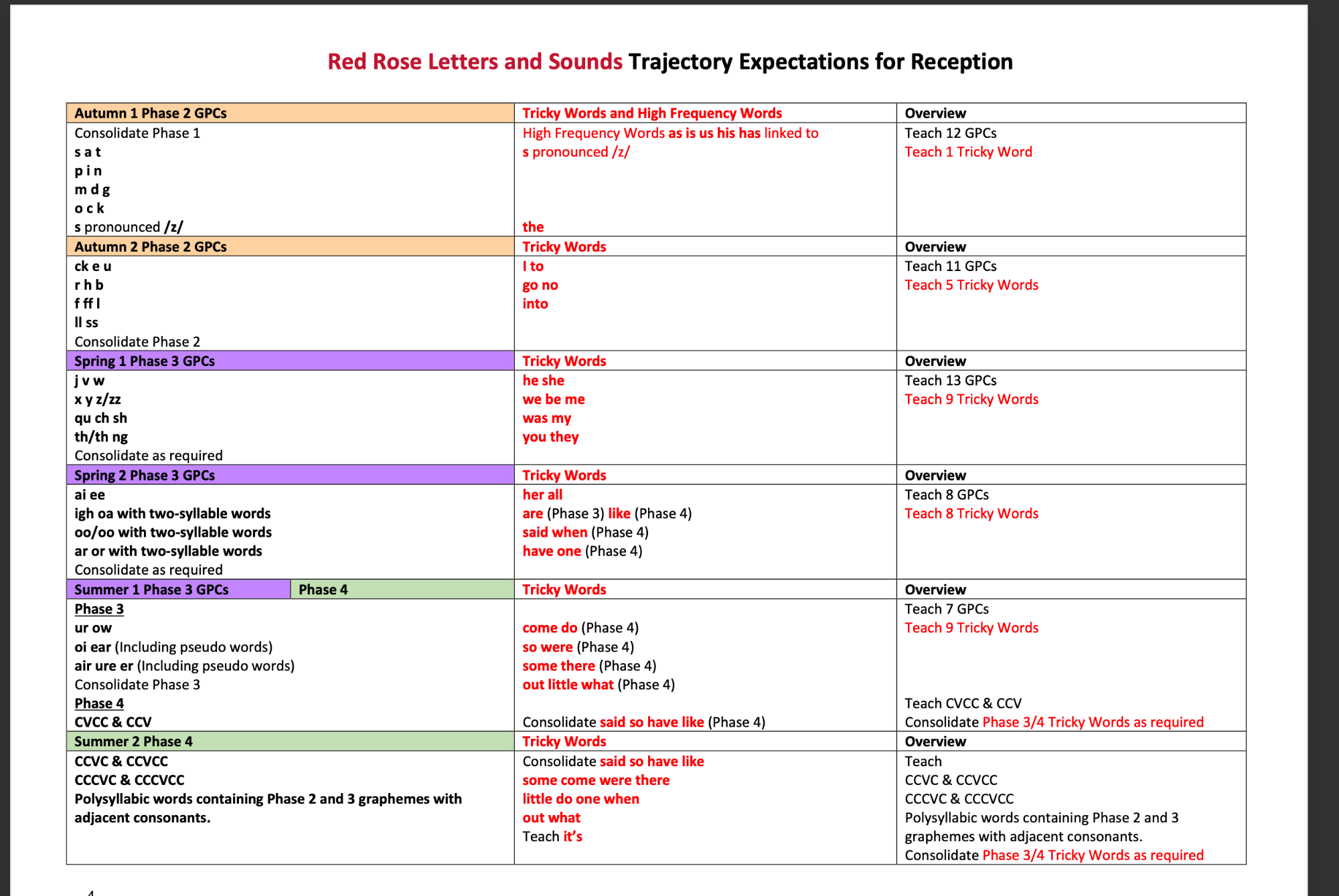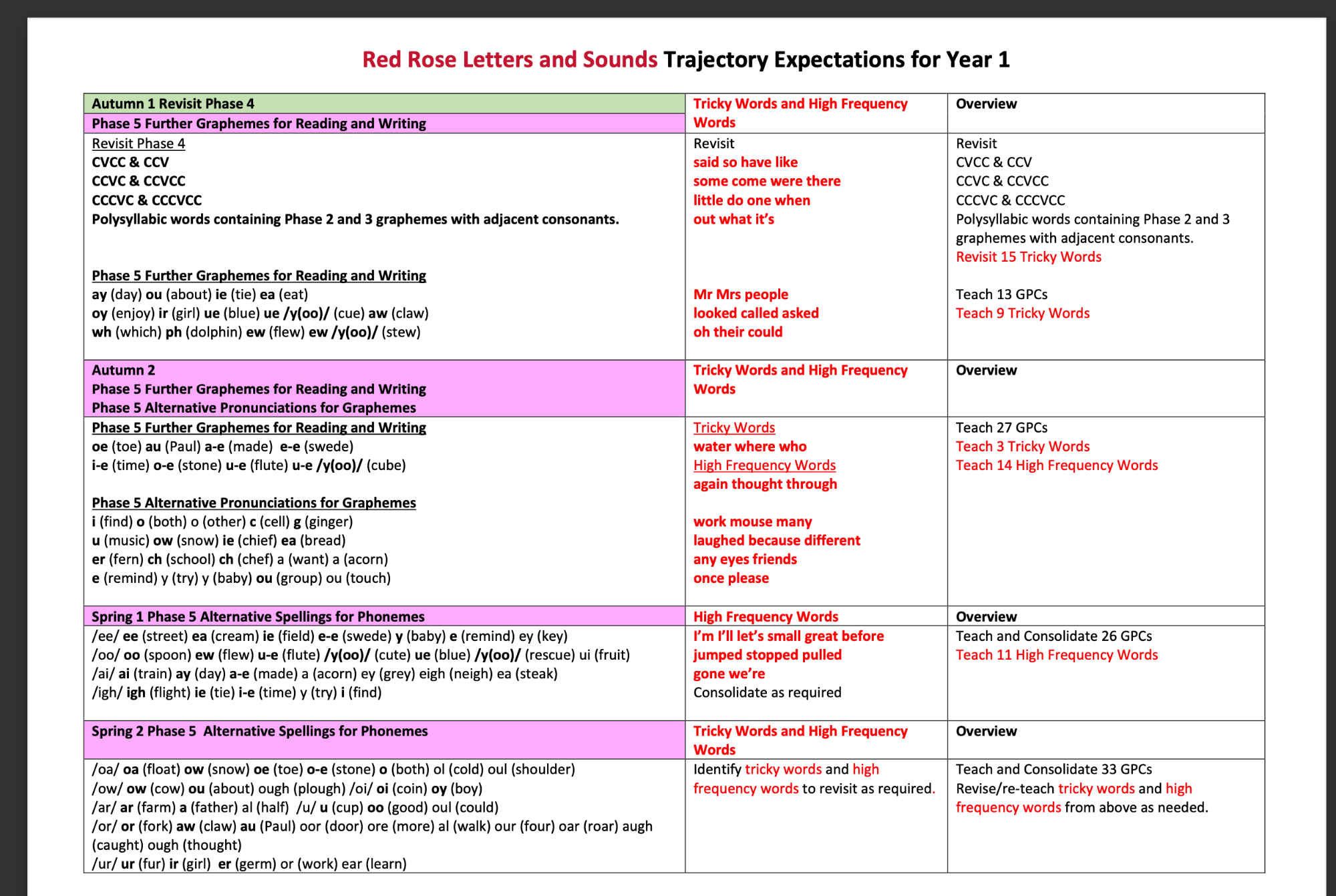Phonics at SMSA
What is phonics?
Phonics is a proven and effective way of teaching children to read. By ensuring high quality phonics teaching, we want to improve literacy levels and give all children a solid base to build on, as they progress through school. Through phonics children are taught how to:
• recognise the sounds that each individual letter makes
• identify the sounds that different combinations of letters make - such as ‘sh’ or ‘oo’
• blend these sounds together from left to right to make a word. Children can then use this knowledge to ‘decode’ new words that they hear or see.
INTENT
Our Curriculum has been designed to ensure that all our children can ‘be the best people that they can be’ by offering stimulating and awe-inspiring learning experiences, with our Catholic values at the heart.
It is designed to meet the needs of the pupils at St Mary and St Andrew’s, not only by focussing on appropriate subject specific knowledge, skills and understanding as set out in the National Curriculum, but by modelling the virtues given to us by Christ. Our aspirational curriculum intends to develop individual and collaborative learning experiences; a positive, growth mindset; a sense of responsibility and provide challenges that take learning beyond the classroom. We are determined that every pupil will learn to read, regardless of their background needs or abilities. Being able to read is the most important skill children will learn during their early schooling, as it enables them to access all other areas of the curriculum and help build a rich vocabulary. We aim to teach high quality phonics, to ensure children have the best possible start in reading and writing.
IMPLEMENTATION
Phonics is taught every day in EYFS and KS1 using the Lancashire Red Rose letters and sounds scheme, with fidelity. Children are taught phonics daily (discrete phonics), in groups, led by a teacher or teaching assistant, all of whom are trained to use the Red Rose Phonics programme. Lessons are sequenced, with clear end points. Phonics grouping at our school is varied and fluid, depending on the needs of the child.
All lessons across the phases follow the same structure, as outlined below;
REVISIT & REVIEW: Revise previously taught sounds and graphemes, plus High Frequency Words (HFW) and ‘Tricky words’
TEACH: Introduce new sounds and graphemes using the three part example; hear it and say it, see it and say it, then say it and write it. Staff model and ‘sound talk’ words with the new sounds and graphemes
PRACTISE: Children practise new and revised sounds and graphemes by segmenting and blending sounds together, to read and write words
APPLY: Children extend their core skills with words and sentences containing the newly taught graphemes plus Tricky/HF words, combined with previous learning
New phonemes are taught using the correct articulation and terminology. Children will become familiar with this terminology in their learning. e.g. digraphs, trigraphs, split-digraph.
Phonics is not only taught discreetly, but embedded in all areas of the curriculum, as children are encouraged to use and apply their phonic knowledge. This ensures that children are developing their 'sticky learning', resulting in them knowing more, remembering more and using their skills and knowledge in context.

IMPACT
As with all areas of learning, our children's progress and achievement in phonics will be rigorously monitored, highly valued and reflect the success of every individual. Children will be supported to 'be the best that they can be' academically, personally, emotionally, socially and faithfully. By the end of the summer term of Y1, we expect all children to be secure at Phase 5 phonics and be able to read age-appropriate books independently. Our aspiration is that all our children will be independent, fluid and avid readers by the end of KS1.
Year-on-year, we are consistently inline with, or above, the national picture for phonics. We are very proud of our data; we are very proud of the progress of our children.
What happens if my child is struggling to keep up with Phonics teaching?
If your child needs extra help with phonics - then don't worry! As we formatively assess the children's knowledge every day, we can immediately address any misunderstandings or gaps in knowledge. If deeper support is needed then we will facilitate additional, intervention sessions during the school day, from our highly trained staff.
Do you have a child in Year 1?
If so, your child will be participating in the Phonics Screening Check (PSC) that takes place in June. The purpose of the phonics screening check is to test your child’s phonic knowledge and confirm that they have learned phonic decoding to an age-appropriate standard.
Each child will be asked to read aloud a list of 40 words, by identifying and saying sounds and blending them together; words are a mix of real and pseudo words. The words will use phonemes and graphemes from across phases 2, 3, 4 and 5. Previously, the pass score has been 32.
Examples of previous checks can be found via the links below:
https://www.gov.uk/government/publications/phonics-screening-check-2024-materials
https://www.gov.uk/government/publications/phonics-screening-check-2023-materials
https://www.gov.uk/government/publications/phonics-screening-check-2022-materials
There is also a useful video for parents on our website.
Parents are invited twice a year to come to school and learn about phonics, how to help your child and how we are helping this grow in knowledge. The presentation we share is here for you:
Phonics presentation for parents 2025
Phonics Screening Information for Parents from DfE
What if my child does not reach the standard in Year 1?
If a pupil does not meet the expected standard at the end of Year 1, a programme of support will be put in place and they will re-take the check in Year 2. Please talk to your child’s teacher if you have any concerns about this.
We use Red Rose Phonics - this is how we do it!
Lessons are sequenced - with very clear end points. Have a look at our plans to see the order in which we do things.

When we teach the children the phonemes (sounds), we teach them the graphemes (letter shapes) too, there is a particular patter we use to do this and it is here for you to share and practise at home. There is also a pdf for you at the bottom of the page if you wish to print it out - we can do this at school for anyone who would like a copy.

Let's do this together!
Parents play a very important part in helping with phonics. Keeping momentum up while learning at home will really help. Here are some top tips to help your child learn, use and apply phonics skills at home:
- Talk, talk talk! Talk regularly about day-to-day life, and what you’re reading together. Talking is key to helping children hear and pronounce speech sounds, as well as developing their vocabulary. Also point to signs or words when you’re out and about, or listen and talk about the sounds you can hear in the environment.
- Read to and with your children every day! Reading to children is the best way to encourage them to love books and expand their vocabulary beyond spoken language. Just 10 minutes a day makes a world of difference to reading development!
- Say the sounds correctly! Use these 2 simple but golden rules when pronouncing phonemes (sounds);
- It’s important not to add an ‘uh’ at the end of the consonant sound – for example, the sound is /m/ not /muh/).
- Don’t make sounds too long – for example, the letter ‘m’ has a short /m/ sound, not a continuous /mmmmmmm/ sound.
There are lots of videos and tutorials to help with sound pronunciation available on the internet, including this one from Oxford Owl: https://www.youtube.com/watch?v=UCI2mu7URBc
- Repetition, repetition, repetition! Practice makes perfect. Please spend 10 mins each day reading with your child. You don’t need to read the whole book at once. Break it down into manageable chunks and remember to talk about what you are reading. Encourage your child to say the sounds they see automatically, reading from left to write and blend them together to read the word. If your child gets stuck, use the phoneme cards in your child’s reading packet to help. Encourage them to say the sounds in order and do it with them. Apart from library books, all other reading books sent home from school are matched to your child’s current phonic phase and week and are fully decodable. Watch out for ‘tricky words’ though! These are not decodable and have to learnt by heart..
- Enjoy reading! This is key to reading success! We know that with encouragement and praise, children will learn much faster so make reading at home special and fun. We know how busy life is so please involve the whole family so that it’s not just the same person reading with your child.
Once school books start to be sent home, we use ‘book bags’ and a reading record, which is a great way for teachers and parents to communicate about what children have read. The reading record can be used to highlight problems or successes they have had, either at home or at school. Please help us by filling it in each time your child reads. We expect all children to read with an adult every day for at least 10 minutes.
Here are a great selection of resources to help you:
In this hyperlink below is every sound you need, in phase order - have a go together, your children will love showing you how clever they are!
Every lesson - every sound, great fun to help at home!
Book trust book list for 4-5 year olds https://www.booktrust.org.uk/booklists/g/great-books-guide-for-children-2023-4-5/
Nursery rhymes to sing, a key part of CL https://www.bbc.co.uk/teach/school-radio/articles/z4ddgwx
|
Nursery Rhymes and Songs - A to Z Nursery Rhymes. Animated versions of BBC nursery rhymes for children with lyrics. 100+ videos. The Animal Fair...to...Humpty Dumpty...to Wind the bobbin up! www.bbc.co.uk |



